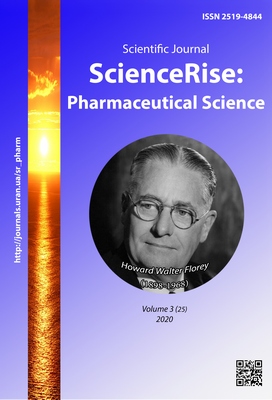Preparation and study of the substance of multicomponent dry extract of Belisa as a stage of pharmaceutical development of sedative capsules
DOI:
https://doi.org/10.15587/2519-4852.2020.206771Keywords:
composition, technology, multicomponent dry extract, excipients, ICQ 8 “Pharmaceutical development”Abstract
The aim. Scientifically and experimentally substantiate the production and study of the properties of the multicomponent dry extract of Belisa in order to formulate a capsule mixture based on it, taking into account the requirements of ICQ 8 “Pharmaceutical Development”.
Methods. Physico-chemical and pharmaco-technological research methods were used to determine moisture, bulk density and bulk density after shrinkage, fractional composition of the obtained multicomponent dry extract of Belisa and model mixtures with excipients based on it.
Results. As a result of experimental studies, a multicomponent dry extract of Belisa was obtained. Humidity, bulk density and bulk density after shrinkage, fluidity of the obtained extract and seven model mixtures with it were determined and microscopic analysis was performed. According to the results of the experiment, the dry extract without the addition of excipients for 2 days lost its flowability, which prompted the use of excipients in its subsequent technology. To improve the technological properties of the dry extract of Belisa, model samples were made with different excipients (Aerosil in the amount of 1, 2 and 3 % and maltodextrin in the amount of 2, 3 and 4 %) and with a different technology.
Conclusions. Physico-chemical and pharmaco-technological properties of multicomponent dry extract of Belisa and its model samples with a number of excipients were studied. Humidity, bulk density and bulk density after shrinkage, fractional composition were studied. According to the results of experimental researches the technology is developed and the technological scheme of obtaining the multicomponent dry extract of Belisa is made and critical parameters of its production are defined
References
- Liapunov, M., Bezuhla, O., Pidpruzhnykov, Yu. et. al. (2012). Nastanova ST-N MOZ Ukrainy 42-3.0:2011. – Likarski zasoby. Farmatsevtychna rozrobka (ICH Q8). Standartyzatsiia farmatsevtychnoi produktsii. Kyiv, MOZ Ukrainy, 6–11.
- Korotkov, V. A., Kukhtenko, O. S., Hladukh, Ye. V. (2013). Vybir optymalnoi tekhnolohii oderzhannia oliinoho ekstraktu plodiv makliury. Farmatsevtychnyi zhurnal, 6, 36–41. Available at: http://nbuv.gov.ua/UJRN/pharmazh_2013_6_6
- Ponomarev, V. D. (1982). Ekstragirovanie lekarstvennogo syria. Moscow, 204.
- Ruban, O. A., Kolisnyk, T. Ye., Slipchenko, H. D., Kovalevska, I. V. (2015). Vyvchennia tekhnolohichnykh vlastyvostei sukhoho ekstraktu dlia rozrobky novoho protydiabetychnoho preparatu. Zbirnyk naukovykh prats spivrobitnykiv NMAPO im. P. L. Shupyka, 24 (5), 218–223. Available at: http://nbuv.gov.ua/UJRN/Znpsnmapo_2015_24(5)__44
- Vyshnevska, L. I., Shmalko, O. O., Soldatov, D. P. (2019). Study on the development of multicomponent dry uroholum extract and its pharmaco-technological indicators. Management, Economics and Quality Assurance in Pharmacy, 2 (58), 16–21. doi: http://doi.org/10.24959/uekj.19.19
- Derzhavna Farmakopeia Ukrainy. T. 1 (2015). Kharkiv: Derzhavne pidpryiemstvo «Ukrainskyi naukovyi farmakopeinyi tsentr yakosti likarskykh zasobiv», 1128.
- Swarbrick, J. (Ed.) (2007). Encyclopedia of pharmaceutical technology. New York: Informa Healthcare USA, Inc., 4372.
- European Pharmacopоeia 9.0. European Directorate for the Quality of Medicines & HealthCare (EDQM) (2017). Strasbourg: Council of Europe. Available at: http://online6.edqm.eu/ep900 Last accessed: 17.10.2017
- United States Pharmaacopeia (2000). Rockville, 2569.
- Pertsev, I. M., Dmytriievskyi, D. I., Rybachuk, V. D. et. al.; Pertsev, I. M. (Ed.) (2010). Dopomizhni rechovyny v tekhnolohii likiv: vplyv na tekhnolohichni, spozhyvchi, ekonomichni kharakterystyky i terapevtychnu efektyvnist. Kharkiv: Zoloti storinky, 600.
Downloads
Published
How to Cite
Issue
Section
License
Copyright (c) 2020 Oleksandr Shmalko, Liliia Vyshnevska, Dmytro Soldatov

This work is licensed under a Creative Commons Attribution 4.0 International License.
Our journal abides by the Creative Commons CC BY copyright rights and permissions for open access journals.








